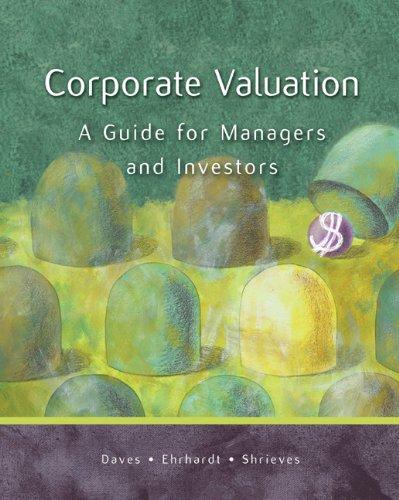DCF analysis of an Investment Decision for a Crop-Dusting Business It was another busy February for the veteran crop duster Dusty Bames. Rather than flying over local agricultural fields, Barnes's winter days were filled with processing a steady flow of phone and online orders for summer business. His calendar already booked through July, Bames knew he would once again be required to start turning away business. With this prospect in mind, he considered whether it was time to expand his capacity to meet customer demand by adding another plane and pilot to his long-standing solo-operation crop dusting business. Crop dusting was the application of chemicals, such as fertilizer and insecticides, to farmland via small aircraft Although large commercial crop-dusting operations were increasingly the norm, a substantial number of small business crop dusters continued to compete successfully. Crop dusting was generally accomplished with a pair of operators in the airplane cockpit. A pilot paided the plane over the fields while the assistance provided navigational assistance to the pilot and managed the dispensing of chemicals In analyzing this capacity investment decision, Bames expected that the new plane would set him back $100,000. With an additional pilot, he expected to to able to work the plane hard for five years, and then be able to sell the plane for about 560,000. Barnen estimated that the weighted average cost of capital (WACC) for the commercial crop-dusting firma was currently 8.5%, but he knew that his local bank would lend the money for the plane purchase at a 6% interest rate. With the basie numbers at hand, Bames stared out at the dark blue winter sky and wondered whether putting another plane in the air was a good idea. The previous week, Barnes had invited a new friend from his local Ruritan Club, Charlie Braw, to lunch. Aber dropping $50 on a tasty meal at the Hearty Hanger restaurant, Bares confirmed that Bravo was a reasonable skilled pilot and had extra time on his hande. Barnes thought he could hire Bravo as a pilot for $85,000 AARON, and he could find an amant to work with him for $40,000 Rames gave his costant, Pei Roel, a call and found out that the new plane would be depreciated for tax purposes over 10 years on a straight-line basis. Roel explained that the depreciation was an important way to shield profits from the prevalling marginal tax role of 40%. She reminded Bames that dusting services fended to come with payment terms that allowed 30 days of credit. The incremental storage, maintenance, and insurance costs were expected to run $20,000 per year. The going price for crop dating was $20 an acre. Bares estimated that he could book an additional 10,000 acres for the upcoming season if he had Bravo's help Considering that fuel costs were running at $3.75 an acte, sbould be move forward with expanding his business? Why or not? What is the key driver of revenue in this line of business? (Complete the Base Case) Next, consider the impact of inflation on your recommendation to Bares. Why does inflation matter? Should Bernes move forward after considering the effect of inflation? Why or why not? (Complete inflation adjusted Spreadsheet). Key steps in your analysis are the following: Provide assumption inputs in the highlighted cells Complete the statement of free cash flow Key items of interest in the cash flow statement are the following 1. Revenue Estimate 2. EBIT 3. Net working capital 4. Net fixed assets 3. Net operating profit after tax (NOPAT) 6. CAPEX 7. ANWC 8. FCF 9. NPV FCF - NOPAT + Depreciation & Amortization - CAPEX-ANWC FCF - NOPATANPA ANWC where NOPATEBITX (1-1) ANPA-CAPEX - Depreciation & Amortization Base Case: DCF Analysis for new-plane investment Assumptions 10 11 12 13 Additional acres (000) Price per acre Fuel cost per acre Annual cost of pilot (000) Annual cost of assistant (000) Storage, maint, and ins. Cost (000) Receivable days Initial cost of plane (000) Salvage value of plane in Year 5 Depreciation rate Tax rate Discount rate 14 15 16 17 18 19 Calculation of Free Cash Flow Year o Year 1 Year 2 Year 3 Year 4 Year 5 20 21 22 23 24 25 Revenue Operatting cash costs Depreciation EBIT 27 28 Net working capital Net fixed assets 29 30 31 32 Net operating profit after tax plus Depreciation Less CAPEX Less ANWC 33 34 35 36 FCF NPV 37 38 39 NPV 41 43 46 Salvage Value Calculation Expected salvage value Tax on gain Expected after-tax salvage value Calculation of Tax on Gain Expected salvage value Tax on book value Gain Tax on gain (40%) 53 56 &&988@S8 & S8$a 64









